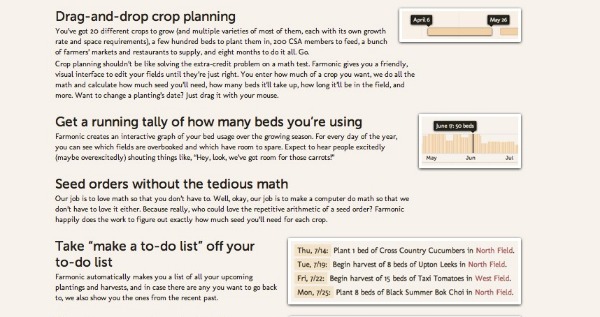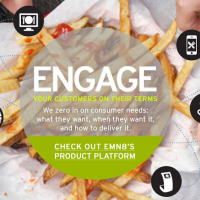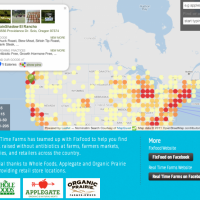Last year, my friend Sam, a retail operations manager of a CSA and agritourism farm, asked if I could help him find software that would enable him to connect the back and front-ends of the farm he managed.
He explained: ‘First you have to plant the seeds and make projections about yields, taking into account a number of factors such as weather and soil quality. Then, once the vegetables are harvested, you need the people working in the fields and the farm manager to capture and communicate the actual yields, often done on a piece of paper. Then I spend half of my time chasing after the farm manager to get a count of the vegetables available for the CSA pickup the following day.’
This is the over-simplified version of the story, but it elucidates the incredible amount of logistics and information farms must coordinate from seed to consumer. Just think about how much information flows through a farm and how difficult it is to manage. The sector is ripe for some information management disruption, especially given the younger, tech savvy movement of farmers that is emerging across the country.
Which is why I was excited when Kareem Shaya emailed me to tell me about his startup Farmonic, a field management platform for sustainable farms. Shaya is a developer with no agricultural background, but recognizes the immense opportunity to use information technology to address the challenges farmers face managing their fields. After the first month trial period, the service costs between $19 -$400, depending upon the size of your farm.
What I’m particularly impressed by is Shaya’s approach to developing the platform, which focuses on the user experience to ensure that farmer’s find it easy and useful to engage with. Our interview looks at his approach, the inspiration behind farmonic, his challenges, and offers some really interesting insights into the psychology of the farmer.
—-
Danielle Gould: What is the inspiration behind Farmonic?
Kareem Shaya: You know that line in The Godfather, “This is business, not personal”? Well, this is the exact opposite. I first got interested in sustainable farms and local food as a customer, when I signed up for my first CSA a couple years ago. I come from a design and user interface background, so anytime I like a product, I start thinking about how it works.
So I started talking to farmers. Email, phone, going to visit them, etc. And what I discovered is that farms run like a lot of other small businesses — with a mix of paper records, mental juggling, and jury-rigged Excel spreadsheets. For a small office, that’s workable. But a farm is so much more complicated. Your typical sustainable farm might be growing 20 crops, each one with its own requirements for how, when, and where you plant it, its own harvest window, its own list of crops that it shouldn’t follow, and on and on. You have a few months to figure out while simultaneously handling a) a couple hundred customers, and b) all the unpredictability that comes with having a couple fields full of living, dynamic organisms.
It’s like solving the world’s hardest word problem. Oh, and the penalty for getting it wrong is that you go poor. So it shocked me that there’s virtually no user-friendly platforms out there to help farmers do their crop planning and field management. You’ve got thousands of farmers doing these incredibly complex logistics basically on the back of a napkin, and nobody’s got anything better for them. Farmonic is the first step towards fixing that.
DG: How does the site work?
KS: It’s an app for field management and crop planning, and it’s all web-based. You enter how much of a crop you want to grow this year — say, 5000 pounds of sun gold tomatoes — and a couple basic stats about how the crop grows, then Farmonic calculates the rest. How many beds you’ll need to plant, how much seed you’ll need, and so on. The site is drag-and-drop, so to schedule plantings, you literally drag them to whatever day of the year you want them. It’s all super-intuitive. Your planting schedule is a visual schedule, not a column of dates in a spreadsheet that you have to decipher.
Danielle Gould: You mentioned that you don’t have any background in agriculture. Could you talk about how a tech guy goes about building software for farmers?
KS: Great question. I did lots and lots of research. Massive amounts of research. Did I mention research? I had to figure out exactly what it’s like to be a farmer, because good software, at its heart, is software that completely understands its users.
So I talked to farmers. I visited them. My friends at First Root Farm in Massachusetts let me actually work with them in the field for a day, pulling weeds and making beds. (I was embarrassed to tell them that my usual definition of physical labor is when I have to stand up to plug in my laptop.) I spent ages poring over spreadsheets and crop plans, looking at all the paperwork behind a working farm. Eventually I made a crop plan for my own imaginary farm. That got me to the point where I could build Farmonic with a good understanding of what farmers would actually want from it. (And what things they’d want it to stay out of the way on.)
Oh, and I did lots of research.
Danielle Gould: Farmers don’t tend to be very teck savvy or open to spending significant amounts of time on new products. Who is your target market and how are you addressing those factors?
KS: Farmonic is for sustainable farms, whether they’re on 1 acre or 500 acres. The tech savviness issue is an interesting one. It’s not really that farmers aren’t tech savvy. Plenty of them have a website, run a blog, etc. The hurdle is that they’ve been burned before by software they thought was going to be useful and that turned out to be one more thing to deal with and just a waste of time. So they’re understandably wary.
There’s a great Steve Martin quote about success: “Be so good they can’t ignore you.” That’s what I’m going for with Farmonic. I can talk to farmers all day about how easy it is to use, but ultimately it comes down to them actually using it or hearing about it from a colleague and thinking, “Hey, it really is easy.”
So it’s all about user interface. Simply put, the UI has to be really, really good. Field management software has been done in the past, but it all failed because nobody’s gotten the UI right, they just added complexity. It has to be much better than doing your field management on paper, but simultaneously much easier. People have gotten one or the other right, but I think Farmonic is the first to get both.
DG: Do you have any sense of how many farmers have smart phones?
I heard a statistic from a panel at South by Southwest that 2/3 of farmers either use a smartphone or are planning on using one soon. That’s mind-blowing, and way higher than what most people would guess. I think it bodes very well for the future of tech on farms.
DG: What have been the greatest challenges you’ve faced?
KS: Going back to what I was talking about earlier, Farmonic is fundamentally a user interface product. Getting that right was the core challenge of building it. The basic process is that you hit a hundred dead-ends before finding the path that works, and then you’re constantly refining and tweaking. So I just had to be ruthless about throwing out my own ideas to eventually figure out the right way to do it.
DG: What have been the most interesting or unexpected things you’ve learned while developing Farmonic?
KS: It’s always fun to see the nitty-gritty, behind-the-scenes of running a farm with pencil, paper, and Excel. As much of a hassle as that is, farmers always have these impressive tricks and contortions they go through to make it work somehow.








